






An avid outdoorsman and artist, Trevor Swanson uses the juxtaposition of various patinas on metal to create dramatic backgrounds that give his works amazing realism. Depending on what he feels best complements each piece, Swanson finishes some of his works by framing them with stainless steel or rusted tubing.


“Building on the experience of the play of light in our beautiful desert over this last wintery season, I have really strived to recreate that beauty with the changing effects of the backgrounds,” says Swanson. “We have so many different stages of seasonal color that it makes for an incredible resource of inspiration.”
Swanson also welcomes commissions. Call Sue Bickerdyke Interiors, Home Furnishings & Art Gallery at 480-595-0171 to schedule a personal appointment with the artist and discuss the perfect custom piece that will accentuate your home.

Evening Gathering, oil and patina on metal. 48” by 24”
Monsoon Azure, oil and patina on metal. 24” by 36”
TREVOR SWANSON TREVOR SWANSON









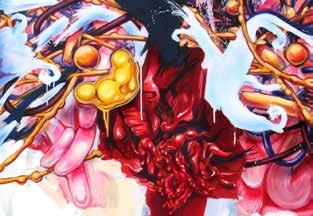



Publisher
Shelly Spence
Managing Editor
Joseph J. Airdo
Graphic Designer
Meaghan Mitchell
Contributing Writers
Joseph J. Airdo
Amanda Christmann
Francine Coles
Rebecca L. Rhoades
Shannon Severson
Photographers
Francine Coles
Loralei Lazurek
Carl Schultz
Advertising Sales
Cindi Calcinari
860-966-3271
cindi@imagesaz.com
Images Arizona
P.O. Box 1416
Carefree, AZ. 85377
623-341-8221
imagesarizona.com
This special summer edition of Images Arizona showcases some of the captivating culture, history and stories of humanity that can be experienced through targeted trails and tours around our state. Our architecture, our art, our natural resources and our food reveal a record of why Arizona is the jewel of America. There is a wealth of insight and adventure that awaits those who seek it.
Meanwhile, our photo essay is devoted to some of the exciting expeditions around Arizona that you — our remarkable readers — have been enjoying so far this summer. We’ve also included information that we believe will be incredibly helpful to parents and students, ensuring that this issue remains a valuable resource as we transition from summer to fall.
It is important to note that summer is not over just yet, though. There is still plenty of time to explore your surroundings, embark on road trips, experience adventures and discover details about Arizona that you never knew. Spending time in the swimming pool or an airconditioned movie theater is nice, but there is so much more that our state has to offer.
I hope that this issue inspires you to gather a group of your family, friends or neighbors and set out on a journey through Arizona’s architecture, food, wine, water, mountains, murals or minerals. Thank you for allowing us to be a part of your summer!
Cheers!
Shelly Spence Publisher, Images Arizona magazine
shelly@imagesaz.com
Publisher, Images Arizona magazine
shelly@imagesaz.com
623-341-8221






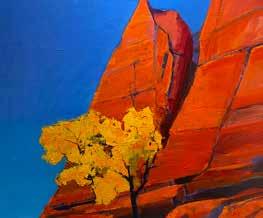
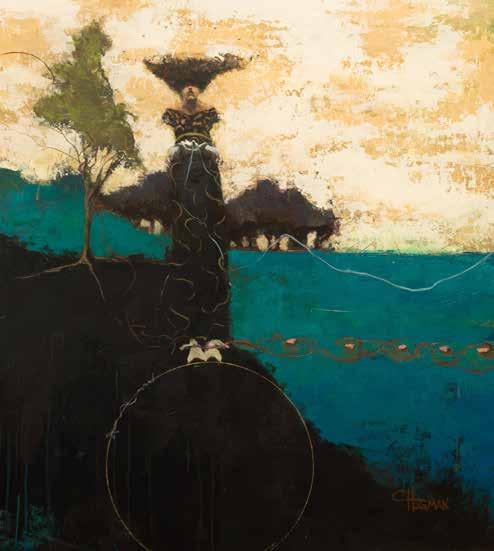


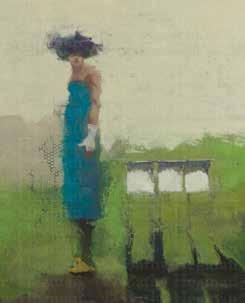

PPhoenix is known for many things: its perpetually blue skies and warm temperatures, its stunning desert landscapes, its vibrant culture filled with Native American and Mexican influences and its spicy Sonoran cuisine. But for architecture buffs, the Valley of the Sun offers another attraction: a plethora of midcentury modern homes and buildings.
According to the National Register of Historic Places, Phoenix has the second-largest concentration of midcentury modern architecture in the country. Its California neighbor Palm Springs comes in at No. 1. Both cities have attracted visionary architects who created sleek residences and innovative commercial structures that embraced the sunny environment.

The first non-Native settlers arrived in what is now Phoenix in the mid-1800s. Some of the city’s most historic buildings were constructed during those early years, including the Queen Anne Victorian-style Rosson House, the Spanish Revival-style St. Mary’s Church and the art deco Luhrs Tower.
The arrival of architect Frank Lloyd Wright in the late 1930s brought with it a new aesthetic — a more utilitarian one that embraced sleek lines, minimalist decor and a connection to the surrounding natural environment. As the city continued to grow, especially following the end of World War II, residents and local architects fully embraced this design movement known as “midcentury modernism.”
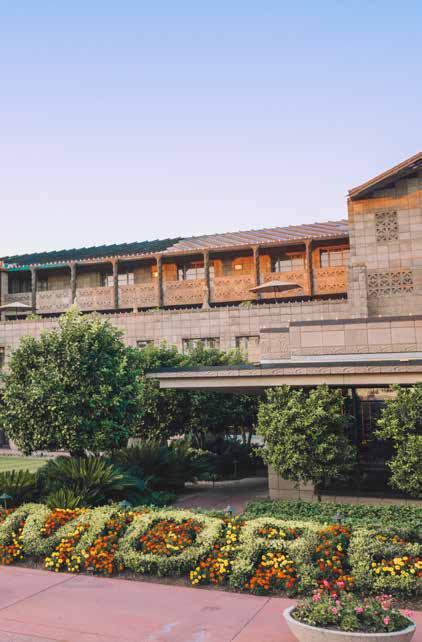
What exactly is midcentury modern design? A response to post-war optimism and the fussy styles of the art deco-jazz age that included tufted furnishings; chintz, floral and plaid fabrics and wallpapers; and wall-to-wall carpeting.
Midcentury modern homes, on the other hand, showcased a more orderly, stripped-down look. Clean lines and sharp angles, concrete floors, floor-to-ceiling walls of windows, open floor plans, and the use of organic materials such as stone and natural wood, were defining elements of the era. The emphasis was on functionality over ornamentation.
From the 1940s through the ’60s, neighborhoods filled with low-slung midcentury modern homes began to pop up around the Valley. Eye-catching businesses with dramatic rooflines and expansive glass fronts lined the main streets. Innovative construction materials, such as precast concrete, breeze block and modular components, became commonplace.
By the 1970s, midcentury modern design had fallen out of style, replaced by planned communities filled with ranch houses and street after street of identical-looking beige faux-Pueblo — and later faux-Tuscan — homes. But recent years have seen a resurgence in the demand for the midcentury modern look. Luckily, many of these original structures survived and have been carefully restored to their former glory.
The leader of the Valley’s midcentury modern movement was Frank Lloyd Wright. In the late 1930s, the architect built a winter home in what was then the middle of nowhere — 26 miles from downtown Phoenix, in the foothills of the McDowell Mountains. Known as Taliesin West — named in concert with his home and studio in Spring Green, Wisconsin — the residence also served as a place to train his apprentices.
Wright and his students built the home by hand, using rocks and sand culled from the surrounding area to ensure that the structures looked as though they were an extension of the desert floor. Mixed with concrete, the stone composite became known as desert masonry. It is used on the exteriors of virtually every building at Taliesin West, and it became a characteristic element of Wright’s Southwest designs.
During the next 20 years — the architect passed away in 1959 — Wright designed and constructed multiple buildings throughout the Valley. Some are private homes; others are open to the public.


Two of the most easily accessible structures are Grady Gammage Memorial Auditorium at Arizona State University and First Christian Church in Phoenix. Considered by many to be the crowning jewel of ASU’s Tempe campus, the auditorium, which seats more than 3,000 people, features 50 columns that frame the glass-walled lobby. It was one of Wright’s final projects. The church was commissioned in 1949 but not built until the early ’70s. It is defined by its towering roof spire filled with stained glass and a dramatic freestanding stone-and-concrete bell tower that appears to be floating above the grass.
The Price House, located on Tatum Boulevard just north of Lincoln Drive, was built in 1954 as a winter retreat for Harold and Mary Lou Price, who just two years earlier had commissioned the architect to create the now-famous Price Tower in their hometown of Bartlesville, Oklahoma. At 4,500 square feet, it is the largest Wright-designed dwelling in Arizona with seven bedrooms, seven bathrooms, and a large central atrium with a fountain, fireplace and open skylight. The house occasionally is opened for corporate and charity events, as well as public tours.
While the Arizona Biltmore hotel is often credited to Wright, the extent of the architect’s involvement was limited. What is known is that Albert Chase McArthur incorporated Wright’s textile block construction — precast blocks with a geometric pattern made on-site from desert sand — resulting in an appearance that echoed many of Wright’s residential designs.
Future renovation would play up the hotel’s connection to Wright. A large stained-glass window designed
by Wright and fabricated by Taliesin students was installed in 1973. It greets visitors near the front entry. Reproduction “sprite” statues, also designed by Wright, dot the property. Officially, the complex is recognized as a collaboration between Wright and McArthur, a former draftsman at Wright’s studio.
Architect Ralph Haver is best known for designing modest tract homes from the 1940s to the early ’80s. His signature midcentury modern dwellings — known as Haver Homes — are characterized by their low-slung single-gable roofs, floor-to-ceiling and clerestory windows, and patioports, covered patios that connect the carport to the main house.


A number of “Haverhoods” remain scattered throughout the Valley. Some of the most popular include Marlen Grove in midtown Phoenix, Windemere in Arcadia and the Town & Country communities in Scottsdale and north Phoenix. These darling neighborhoods are chock-a-block with Haver Homes that have been meticulously restored or updated with contemporary design features. Brightly colored front doors, mature foliage and vintage cars add to the picture-perfect appeal.
Originally built as affordable starter houses, Haver Homes now fetch upward of $1 million.
Another architect whose Valley residences command top dollar is Alfred Newman Beadle. Inspired by Bauhaus and greats such as Mies Van Der Rohe, Beadle designed homes and apartments, including the only case study home outside of California, the Triad apartment complex on North 28th Street.
Two of Beadle’s most well-known works are the landmark 21-story Executive Towers complex and White Gates, one of the city’s most Instagrammed architectural sites. Nestled at the base of Camelback Mountain, surrounded by contemporary McMansions, the tiny ultramodern box is defined by its white ellipsoid bris-soleil. It has never been lived in and, sadly, now sits abandoned. Next door is a similar white Beadle creation, the Uhlmann home, which has been lovingly rehabbed to showcase its characterdefining breeze block walls.

Of course, these three masters are just the tip of the modernist iceberg that is Phoenix’s architectural legacy. Adding to the design landscape is Bennie Gonzales, an Arizona native whose work merged modernism with regionalism. Some of his signature details were parabolic arched windows and doorways and glass-tiled roof canales. Gonzales is best known for his work on the Scottsdale Civic Center and Gloria Dei Lutheran Church in Paradise Valley.

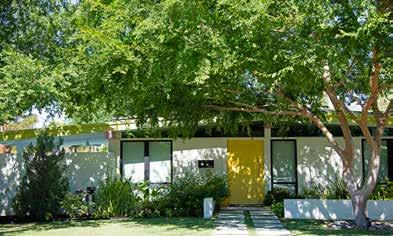
Blaine Drake was one of Frank Lloyd Wright’s original apprentices. He built hundreds of houses across the region, but his largest work was the Unitarian Universalist Church at 40th Street and Lincoln Drive.
On the commercial side, some must-see buildings include the Phoenix Financial Center on Central Avenue. Designed by Peruvian architect Wenceslao Sarmiento, a student of Oscar Niemeyer, the eye-catching complex consists of a curved tower and two rotunda buildings. The glass rotundas are wrapped in sweeping parabolic arches that call to mind the arched designs of Niemeyer and Broyhill’s famed Brasilia line of furnishings.
The Valley National Bank building, now a Chase bank, at 44th Street and Camelback Road is fronted by a forest of concrete dendriform columns. The whimsical shapes recall “Alice in Wonderland’s” magic fungi or the Seussian baobab trees of Madagascar. Architect Frank Henry was inspired by the mushroom-shaped columns of Wright’s Johnson Wax Headquarters. The curved main building is clad in a stone and concrete finish, echoing Wright’s desert masonry. Henry later went on to teach at Taliesin West.
Across town, the 300 Bowl and the Western Savings building are two of the city’s most unique structures. The 300 Bowl, also known as Bowlera, features a dramatic three-point Googie-style roofline, while the circular Western Savings building, also designed by Sarmiento and used for many years as a Souper Salad restaurant, is known for its funnel-like roof structure that’s reminiscent of a crown roast. Today, the building is home to a gun store.
Modern Phoenix is a local organization that’s devoted to celebrating and preserving the area’s midcentury architecture and design. Its website is a treasure trove of information, from profiles of architects to stories and photos of buildings long since demolished. And each year, the organization puts on Modern Phoenix Week, the Valley’s answer to Palm Springs’ Modernism Week — which includes lectures, visits to architectural studios and the always popular home tour.
modernphoenix.net

Through Aug. 6
‘VISIONS ‘23’
Scottsdale Arts Learning and Innovation hosts an exhibit that highlights the skills, inspirations and ideas exchanged between students and professional teaching artists over the course of its Visions program. $10+; student, senior, veteran and member discounts available. Scottsdale Museum of Contemporary Art, 7374 E. Second St., Scottsdale. scottsdaleartslearning.org
Through Aug. 12
The Phoenix Theatre Company hosts a series of summer camps for young performers. See website for price and schedule. The Phoenix Theatre Company, 1825 N. Central Ave., Phoenix. 602-254-2151; phoenixtheatre.com
Through Sept. 2
‘ON GOLDEN POND’
Don Bluth Front Row Theater presents its production of “On Golden Pond.” $30; youth, student, senior, military and group discounts available. See website for times. Don Bluth Front Row Theater, 8989 E. Via Linda, Suite 118, Scottsdale. 480-314-0841; donbluthfrontrowtheatre.com
Through Sept. 24
‘KIDS IN FOCUS’
Scottsdale Public Art hosts an exhibition of images produced by participants in its Kids in Focus after-school program, which provides a perspective and a voice to 10- to 14-year-olds who have experienced poverty, homelessness, neglect or abuse. Free. Civic Center Public Gallery at Scottsdale Civic Center Library, 3948 N. Drinkwater Blvd., Scottsdale. scottsdalepublicart.org
Through April 29

‘COMING TO TERMS’
Artwork by Bill Dambrova Scottsdale Arts Learning and Innovation will host an exhibition that invites audiences to ask themselves how artwork makes them think and feel. Free. Center Space Gallery at Scottsdale Center for the Performing Arts, 7380 E. Second St., Scottsdale. scottsdaleartslearning.org
Aug. 2–Sept. 3
‘DREAMGIRLS’
The Phoenix Theatre Company will present its production of “Dreamgirls.” See website for price and times. The Phoenix Theatre Company, 1825 N. Central Ave., Phoenix. 602-254-2151; phoenixtheatre.com
Aug. 5, Sept. 2 and Oct. 7
ANTHEM CARS AND COFFEE
Anthem Cars and Coffee will host its monthly car show. Food trucks and vendors will also be on-site for the event. Free. 7–10 a.m. Outlets North Phoenix, 4250 W. Anthem Way, Anthem. anthemcarsandcoffee.com
Aug. 12 and 13
CELEBRATE HIP-HOP
The Musical Instrument Museum will host a special event celebrating the 50th anniversary of hip-hop with dance workshops and musical performances. See website for schedule of events. $20; youth discounts available. 9 a.m.–5 p.m. The Musical Instrument Museum, 4725 E. Mayo Blvd. Phoenix. 480478-6000; mim.org
Aug. 18–27
‘25TH ANNUAL PUTNAM COUNTY SPELLING BEE’
Desert Foothills Theatre will present its production of “The 25th Annual Putnam County Spelling Bee.” See website for prices and times. The Holland Community Center, 34250 N. 60th St., Scottsdale. 480-4881981; dftheater.org

Aug. 18–Sept. 3
‘BLOOMING CACTUS’
The Theatre Artists Studio will present its production of “Blooming Cactus,” a witty new comedy set at an independent living center in Yuma. See website for prices and times. The Theatre Artists Studio, 12406 N. Paradise Village Parkway East, Scottsdale. thestudiophx.org
Aug. 18–Sept. 3
‘FINDING NEMO, JR.’
Scottsdale Desert Stages Theatre presents its production of “Finding Nemo, Jr.” See website for price and times. Scottsdale Desert Stages Theatre at Fashion Square, 7014 E. Camelback Road, Suite 0586, Scottsdale. 480-483-1664; desertstages.org
Aug. 18–Sept. 3
‘TOM FOOLERY’
Fountain Hills Theater presents its production of “Tom Foolery,” a musical about Harvard-educated math professor Tom Lehrer. See website for prices and times. Fountain Hills Theater, 11445 N. Saguaro Blvd., Fountain Hills. 480-837-9661; fhtaz.org
Aug. 26–Oct. 8
‘THE VERY HUNGRY CATERPILLAR SHOW’
The Madison Center for the Arts will present its production of “The Very Hungry Caterpillar Show,” a special event in which Eric Carle’s beautifully imagined stories come to life with a variety of enchanting puppets. $15+. See website for times. The Madison Center for the Arts, 5601 N. 16th St., Phoenix. 602-664-7777; themadison.org
Sept. 2 and 3
EXPERIENCE BRAZIL
The Musical Instrument Museum will host a special event during which attendees will discover how African and Latin American cultures influenced the music of modern Brazil. See website for schedule of events. $20; youth discounts available. 9 a.m.–5 p.m. The Musical Instrument Museum, 4725 E. Mayo Blvd. Phoenix. 480-478-6000; mim.org
Sept. 6–Nov. 26
‘LADY DAY AT EMERSON’S BAR AND GRILL’
The Phoenix Theatre Company will present its production of “Lady Day at Emerson’s Bar and Grill,” a tour-de-force portrait of the iconic jazz songstress Billie Holiday. See website for price and times. The Phoenix Theatre Company, 1825 N. Central Ave., Phoenix. 602-254-2151; phoenixtheatre.com
Sixteen juried professional plein air artists will paint from Prescott’s beautiful forests, lakesides and downtown historical and architectural beauty as Yavapai College Prescott Art Gallery and the Highlands Center for Natural History present the city’s fourth annual plein air festival. The public is invited to observe and engage with the artists as they create their art at specific accessible demonstration sites. Free. See website for map of locations. yc.edu/v6/art-galleries

Sept. 13–17
‘CORTEO’
Cirque du Soleil will return to Phoenix to present “Corteo”
— an enchanting arena production that brings together the passion of the actor with the grace and power of the acrobat to plunge the audience into a theatrical world of fun, comedy and spontaneity situated in a mysterious space between heaven and earth. See website for price and schedule. Footprint Center, 201 E. Jefferson St., Phoenix. cirquedusoleil.com
Sept. 15–17
JUNK IN THE TRUNK VINTAGE MARKET
WestWorld of Scottsdale will host an event that provides attendees the opportunity to support more than 160 small
businesses from across the country while shopping a vast selection of clothing, jewelry, furniture, vintage, decor and more. $8+. See website for hours. WestWorld of Scottsdale, 16601 N. Pima Road, Scottsdale. junkinthetrunkvintagemarket.com

Sept. 15–Oct. 1
‘THE ADDAMS FAMILY’
Fountain Hills Theater presents its production of “The Addams Family.” See website for prices and times. Fountain Hills Theater, 11445 N. Saguaro Blvd., Fountain Hills. 480837-9661; fhtaz.org
Sept. 21–Oct. 28
‘DAMN YANKEES’
Don Bluth Front Row Theater presents its production of “Damn Yankees.” $30; youth, student, senior, military and group discounts available. See website for times. Don Bluth Front Row Theater, 8989 E. Via Linda, Suite 118, Scottsdale. 480-314-0841; donbluthfrontrowtheatre.com
Sept. 22–Oct. 8

‘DOGFIGHT’
Scottsdale Desert Stages Theatre presents its production of “Dogfight.” See website for price and times.
Scottsdale Desert Stages Theatre at Fashion Square, 7014 E. Camelback Road, Suite 0586, Scottsdale. 480483-1664; desertstages.org
Sept. 28–Oct. 1
‘WILLY WONKA KIDS’
Desert Foothills Theatre will present its production of “Willy Wonka Kids” See website for prices and times. The Holland Community Center, 34250 N. 60th St., Scottsdale. 480-488-1981; dftheater.org
The Theatre Artists Studio will present its production of “Agnes of God,” a play based on a true story of a possible murder in a convent. See website for prices and times. The Theatre Artists Studio, 12406 N. Paradise Village Parkway East, Scottsdale. thestudiophx.org
Arizona Broadway Theatre will present its production of “Joseph and the Amazing Technicolor Dreamcoat.”. See website for prices and times. Arizona Broadway Theatre, 7701 W. Paradise Lane, Peoria. 623-776-8400; azbroadway.org
Scottsdale Center for the Performing Arts will host the 33rd annual ariZoni Theatre Awards, which promote the visibility, cooperation and growth of theaters in the Valley. The awards are dedicated to recognizing excellence in theatrical performances, as well as individuals who produce exceptional work in all aspects of theater. Youth celebration 5:30 p.m.; adult celebration 8 p.m. See website for prices. Scottsdale Center for the Performing Arts, 7380 E. Second St., Scottsdale. scottsdaleperformingarts.org
This summer, Rosie’s House's Night of Stars Ovation
Gala broke all fundraising records, nearly doubling the amount raised last year with more than $250,000 to support the nonprofit organization’s free music education programs for youth during the upcoming school year. rosieshouse.org
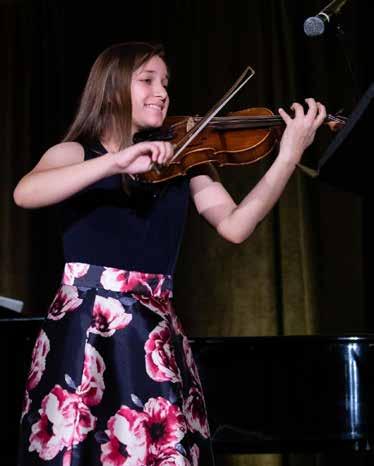
The city of Prescott will host an artist studio tour, giving attendees the opportunity to observe artists as they actively demonstrate their craft, allowing them to learn about the materials, techniques and processes used in creating a work of art while forging a personal connection with the artist. More than 60 juried artists participating in the tour will appear across 45 private studios, with more than 35 additional artists appearing at five area art centers. Free. See website for map of participating studios and art centers. prescottstudiotour.com
Sedona will host its 32nd annual festival, featuring a diverse lineup of more than 100 juried artists from across the country. The renowned fine art festival will also feature live music, raffle prizes, food and a beer and wine garden
— all set against the breathtaking backdrop of Sedona’s red rocks.
$15. Saturday 9 a.m.–5 p.m. Sunday 10 a.m.–4 p.m. Sedona Red Rock
High School, 995 Upper Red Rock Loop Road, Sedona. 928-204-9456; sedonaartsfestival.org
MUSICAL INSTRUMENTS
Rosie's House is accepting donations of musical instruments — specifically playable trumpets, saxophones, violins and cellos. Monday–Friday 10 a.m.–2 p.m. Rosie's House, 919 E. Jefferson St., Phoenix. 602-252-8475; rosieshouse.org

MUSIC SCHOOL LEADER
NAMED YAMAHA ARTIST
This summer, Desert Hills Community School of Music’s artistic director Vitaly Serebriakov was named a Yamaha Artist. The prestigious designation is bestowed upon renowned artists who are active performers and/ or teachers in the music industry, currently play or have expressed a preference for Yamaha instruments and demonstrate a commitment to quality in all aspects of music. deserthillsmusic.org
HHidden beneath the red dirt, rugged boulders and scrubland of creosote and mesquite, are mineral and gem deposits to be discovered by the most intrepid seekers. The story of these precious resources are part of the history and character of Arizona, responsible for the rise, fall and sustenance of towns, industries and natural resources. Many are also prized for their perceived healing properties.

Gem mining in our state dates back to the mid-19th century. The earliest settlers came in search of gold and silver, but copper and gemstones soon became the dominant quest for pick, axe and drill in the early 1900s.
The notable gems detailed here are peridot, amethyst, turquoise and ant hill garnet, but obsidian, fire agate and quartz crystal are also notable for their proliferation and cultural significance.
As “The Copper State” is but one moniker of Arizona — and one of the five Cs that school children still learn about as the industries that drove our early economy — copper remains a vital resource. It was first mined by the Hohokam, Sinagua and Anasazi Native American tribes who used the malleable mineral to fashion jewelry and tools and use for trade. In 1540, near what is now Nogales, the Spanish established the first recorded copper mine in Arizona.
By the early 20th century, mineral patents were granted to mining companies and large operations were established. The Phelps Dodge Corporation became a driving force in the state’s copper industry and developed enormous pit mining operations in Bisbee, Morenci and Bagdad.
This ultimately led to the development of modern mining technology and techniques, which can still be observed at the ASARCO Mission mine near Sahuarita. It’s the only public tour of a working copper mine in the area and also has a free exhibit center, video theater and cactus garden. A one-hour bus tour takes visitors to the open pit mine’s rim and gives them a glimpse inside the grinding mill building.
The Arizona Mining Association is an excellent resource for mine tours, museums and mining exhibits. Copper is still a very much in-demand mineral and is vital to the state’s economy as Arizona remains the top producer of copper in the United States.
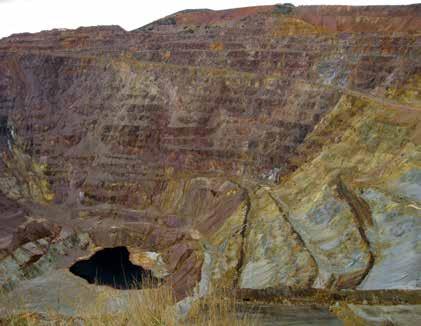

The city of Bisbee is the spot to see where a mine’s boom and bust formed a town that is now a prime tourist destination. The Copper Queen Mine (1880–1975) can still be toured. In sum total, that mine produced approximately 8 billion pounds of copper, along with smaller amounts of gold, silver, zinc and lead, among other minerals.
The Bisbee Mining and Historical Museum offers a comprehensive overview, created in concert with the Smithsonian museums.
Gem mining in our state dates back to the mid-19th century. The earliest settlers came in search of gold and silver, but copper and gemstones soon became the dominant quest for pick, axe and drill in the early 1900s.
Fluorescent and phosphorescent minerals were probably indistinguishable to early miners. But with blacklight, the colors are revealed. How does it do that?




According to Castle Dome Museum CEO Allen Armstrong, it all starts with small impurities in the rocks that serve as activators for the collision of protons and electrons; calcite, fluorite, scheelite, willemite, barite, hydrozincite, aragonite and selenite are activated when hit with black light. The proton collisions in this former silver galena mine continue for up to an hour after the lights go out.
“It looks like a starry night,” Armstrong says of the Hull Mine’s massive 50-foothigh chamber. “It’s like you’re in the Milky Way. Even the sand you stand on is glowing. [Ours is] the most colorful wall on the planet; like a big kaleidoscope that reaches up as far as you can see.”
Founded by Arizona’s first citizen, Colonel Jacob Snively, and William Ehrenbergy in 1864, Castle Dome City and mining district lies just outside of Yuma at the base of Castle Dome Mountain. It was first used to mine gold and silver galena and spans more than seven miles, with 300 patented mines and a full ghost town that was home to 4,000 people back in 1878.
The town holds 80 buildings — including five saloons, a church, banks, mercantiles, a shower house and an operational stamp mill that was used to crush thousandpound rocks. During World War II, 9 million pounds of silver galena was pulled out by the Holmes brothers and the area was mined until the late 1970s when falling silver prices made the endeavor unprofitable. The entire place is a piece of national history and a geological marvel.
“A lot of people go into the mine and say it’s the most beautiful thing they’ve ever seen,” Armstrong says of the glowing chamber 100 vertical feet below ground, discovered in 2017. “There are only three walls like this in the world but the others have only three colors. It’s a mind-blower. These are minerals they had no use for at the time and there are rare earth minerals they didn’t know about.
“The mine is big enough to drive through and even has a blacksmith shop inside. We paved it with 250 yards of concrete and put decking in a few places. It’s 75 degrees inside with good airflow. The Occupational Safety and Health Administration called it the safest mine they’ve ever been in.

“Items we have found inside are in perfect condition. We even found ‘denim gold’ — a 150-year-old pair of Levi’s 201s with no left pocket and no belt loops. There was even a little knife with two blades inside a pocket.”
Armstrong says there is so much left intact that the sights above ground are a treasure trove in themselves. He, his wife Stephanie and a dedicated group of volunteers have painstakingly restored the site, created sustainable power infrastructure and shaped it into a place for the public to enjoy. The CEO adds that it’s impossible to see it all in one day.
“The mining and trails from the Spanish Conquistadors in 1590 are still here,” he notes. “They’ve filmed movies here; it’s the Yosemite of the desert with beautiful trees and landscape. Everybody loves it. You can’t have a museum on 350 acres anymore. It’s not profitable, but it’s something people long for. It’s not commercialized.”



Small group tours of the Hull Mine transport visitors along two miles of old trails dotted with large pieces of metal art and sculpture. Once inside, an underground mine vehicle takes visitors down into the mine and back in time to see the burst of glowing phosphorescent colors and to view an existing silver vein, desperado hideout and blacksmith shop.
castledomemuseum.org
Amethyst is a purple, quartz-based gemstone prized by royalty for its rich violet hue. It is believed that in the 18th century, Spanish settlers discovered what is now the Four Peaks Mine in the Mazatzal Mountains.

The amethyst that comes from within the mine is prized throughout the world for its deep color and flash of “Siberian red,” so called because the only other place in the world where these same characteristics can be found is in the Siberian mines of Russia’s Ural mountain range. It’s the high iron content, manganese and magnesium along with extreme heat that produces the highly prized gemstone color.
Susan Emberley, the general manager of Four Peaks Mining Company in Scottsdale, says the store opened to create a brand for the Four Peaks line of jewelry.
“It requires one ton of mined material to produce two handfuls of gemstones,” Emberley says. “The crystals that come out of the mine are transported by helicopter to be tumbled in Tempe. By the time it is sold in our store, it has traveled around the world.”
Promising pieces that emerge from the tumbling process are sent to Indonesia to be cut to specification by skilled craftspeople. Those cut stones then travel to New Jersey where the owner of the mine sets them himself in sterling silver, marries the gems with designated settings and returns them to Indonesia for completion. The store also sells Four Peaks amethyst set in yellow, rose and white gold.
Emberley says the yellow gold settings are very popular because they really show off the flash of Siberian red. Cleaned, unadulterated crystals can also be purchased by collectors who want to polish and cut the stones themselves.
The store carries an enormous array of gems, minerals and rocks, including metaphysical healing crystals each labeled with their purpose. While Four Peaks Mining Company prides itself on carrying rocks and minerals from Arizona — fluorite from the Lucky Blue Mine; chrysocolla, a decorative secondary copper mineral often mistaken for turquoise, from the Rowley Mine; and turquoise from the Kingman and Sleeping Beauty mines — Emberley says there are gems, jewelry and geological specimens from all over the world.
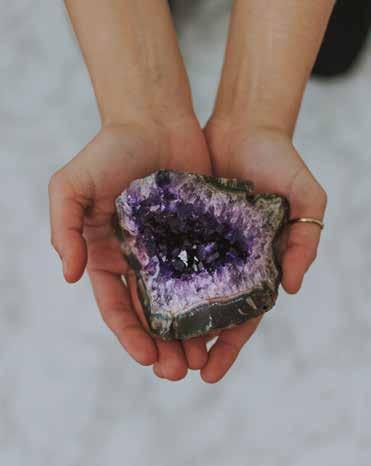
“We also carry wulfenite, which is extremely rare,” she says. “It was named our state mineral in 2017. As miners dig out huge boulders of chrysocolla, they will come across a vein of wulfenite and it is usually damaged in the excavation process, but it’s bright orange and highly sought-after.”
There is even a replica of the mine within the store. Inside, young rockhounds can find and identify up to 30 minerals embedded in the walls and ceilings. In the adjacent blacklight room, naturally fluorescent minerals can be observed. The store is like a museum where one can learn, explore and then actually purchase pieces to take home for personal collection.
“We try to appeal to all ages,” Emberley says. “You can break open geodes and children can buy bags of polished stones. Lots of young kids are junior geologists and they are really into rocks and minerals. They can come in and see specimens from all over the world tagged with names and origins.”
To really get up close and personal with Four Peaks amethyst, the company offers public and private mine tours with access via helicopter beginning in September, weather permitting. Fires and the rock slides that resulted from a total lack of vegetation ravaged the area and destroyed the mine in 2021, but the mining company has been rebuilding ever since and is back to offering exclusive tours by reservation.
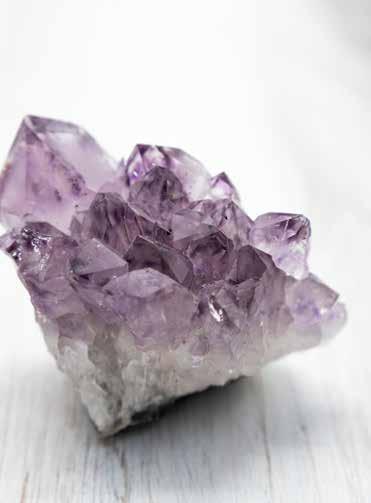
“It’s a once-in-a-lifetime experience and the private tours have really blossomed in this past year,” Emberley says.
fourpeaksminingco.com
Peridot — the traditional birthstone for August and the precious gem-quality version of olivine — varies in color from pale green to deeper olive. The only known location where this gem can be found in the United States is at the San Carlos Apache Reservation near Globe.
Like amethyst, peridot also consists of magnesium and iron. The green hue depends on the amount of chromium or nickel and so ranges from yellowish green to deep green. The higher the iron content, the darker the tint.
Peridot Mesa, as the area is known, consists of volcanic basalt rocks which are painstakingly chipped away by hand to reveal the small, rough green crystals encased in gas cavities. Sometimes the gems will spill out when a cavern is opened. While small, usually one to three carats, they are hard enough to be faceted.
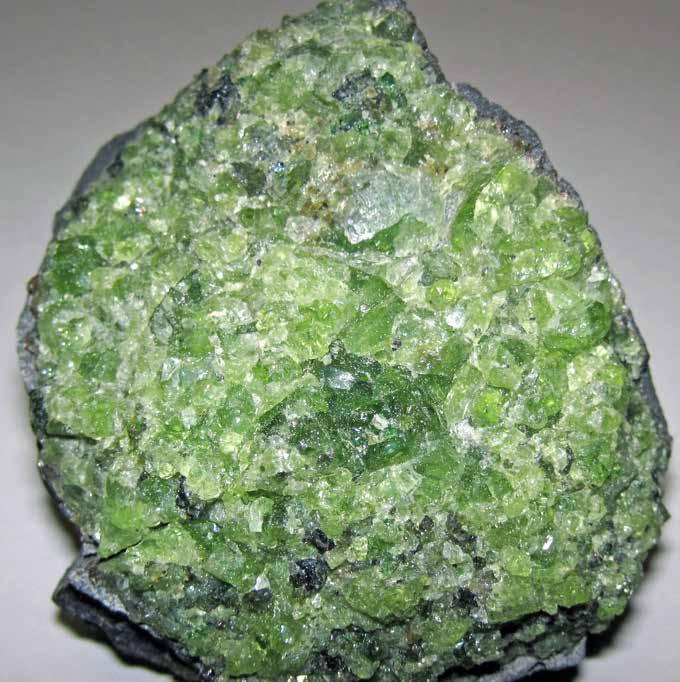
The largest peridot from Peridot Mesa is housed at The Smithsonian and weighs in at a whopping 35 carats.
The mine is not open to the public and mining or collection is strictly prohibited on tribal lands, but rockhounds can do a bit of research on deposits and mining permits in the Williams area.
Turquoise is perhaps the stone most closely associated with the culture and beauty of the American Southwest due to its use in Native American jewelry and the top quality of what is mined and produced here in Arizona.
In fact, turquoise and copper often go hand-in-hand as the deposits are found in tandem. The three most well-known types of Arizona turquoise are named for where they’re mined, including Sleeping Beauty and Kingman. Morenci and Bisbee Blue turquoise come from copper mining in their respective regions.
It’s a delicate stone, and yet mining crews must first blast away the rock and gravel layers that obscure it. Stabilizing processes are often used to make turquoise hard and durable enough to be set in jewelry. Early Native Americans used hot coals to heat rocks that contained the stones, followed by splashing cold water onto them so they would crack, revealing the blue-hued treasure within.
Sleeping Beauty turquoise has a distinctive, sky-blue color and little to no “matrix” — lines that naturally traverse the stone. The Sleeping Beauty Mine is located in the city of Globe, which was founded as a mining camp in 1875. The city’s economy is still largely dependent on the area’s mining industry.
The fairytale name of both the mine and its namesake turquoise refers to the location — a mountain that is said to look like a sleeping woman. Unfortunately, the mining operation ceased in 2012, making the sought-after stones even more precious.
The Kingman Turquoise Mine is the last full-time production mine remaining in the United States. Turquoise mining in the area is believed to date back to the Mayan culture in A.D. 1000, but the mine northwest of Kingman in the Acerbate Mountains has gone through many iterations and ownership since the late 1880s and is now owned by Colbaugh Processing, Inc.
The mine itself is not open to the public but a shop just off Highway 93 has a vast array of turquoise in many colors — blue and green being the most popular — for browsing and purchase. kingmanturquoise.com

It may sound strange, but ant hill garnet is actually mined by ants on the state’s Navajo Reservation. Also known as Arizona ruby, chrome pyrope and pyrope, there’s no set production for these gems since ants aren’t exactly reliable employees. These small, shimmering, bright red stones are beautiful and made even more fascinating by their provenance.
First discovered in the 1500s by the Navajo and Hopi people, the tiny gems rarely weigh over a carat but can be faceted to be set in jewelry. When ants are repairing or digging their ant hills, the garnets they find in their way are pushed up and out of the hill where they spill down the sides and can accumulate for humans to find and collect.
Because these gems are collected on private lands — and mined at the whim of the ant population — the only way to secure an ant hill garnet is through a professional gem dealer or jeweler.



EEarlier this summer, Images Arizona invited its readers to share photos of their expeditions and adventures, eager to see where the road has taken them. From our state’s majestic mountains to its relaxing lakes, the resulting submissions prove that Arizona is home to some of the best summer livin’ on Earth.
We hope that this month’s photo essay reminds you that while our state’s summers can be scorching, they also provide the perfect excuse to explore and experience all that Arizona has to offer. A short road trip in any direction will take you to surreal landscapes, peaceful waters and jaw-dropping rock formations.
Try your hand at paddleboarding, go fishing in a lake, ascend the highest peak, float down a river in a tube or simply lay down and take a nap surrounded by nature. There are plenty of opportunities to live life to its fullest around Arizona — and summer is the absolute best season to do so.
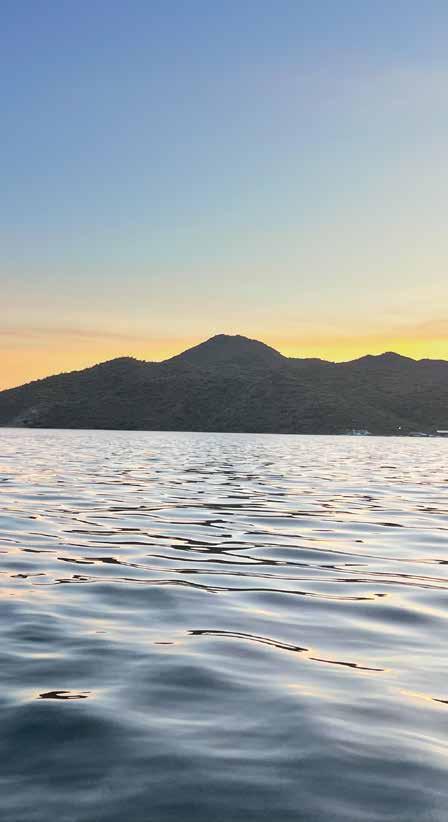
“There is just something magical about water in the desert. Nature is my therapy and I am happiest outside hiking, climbing or paddle boarding. Kelly HahsSaguaro Lake // Photo Courtesy of Kelly Hahs on Instagram (@kelhahs)
We recently visited Guano Point on the West Rim of the Grand Canyon with family in town. My 15-year-old son Mason wanted all of us to hike to the top of the rocks but we were exhausted from a day of ziplining and visiting different lookout points. He went to the top to grab the best view and catch a look at the Colorado River, which made his day.
 Vanessa Weaver
Vanessa Weaver
Camelback Mountain is one of my go-to hikes in the Valley. It is always a good workout to climb this mountain. I love the outdoors and I am always drawn to mountains. They always remind me that we all have our own mountains to climb in life. If you get tired, rest; but never quit. Just keep going. You will overcome these mountains someday.
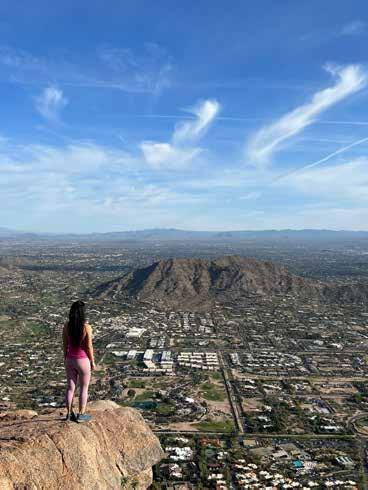 Caren Mitchell
Caren Mitchell
I live about three miles from Watson Lake and it is a regular hangout of mine. Photography was something I have always been interested in but did not have the time while working. After retirement, that is where I spend most of my time. I love landscapes and nature photography — and the Prescott area is home to some of the best of both. Bob Luken





Each bespoke jewel the David Gross Group creates has its own character, its own story. The spectacular quality of each gemstone is further enhanced by the finest craftsmanship and elegant award-winning design.
Featured Sapphire Ring: 20.26 carat Cushion Blue Sapphire with two Trapezoid Modified Brilliant Diamonds 2.41 carats set in a handmade Platinum ring

7212 E. Ho Hum Rd. # 7 | Carefree, AZ 85377
Hours Tue.–Sat. 10 a.m.–5 p.m. By appointment Sun. and Mon.
480.575.8080
GraceReneeGallery.com
I was sitting on my back patio in Scottsdale, hoping to get some good bird photos, when this little guy showed up on a cactus. I wondered why he chose such an uncomfortable-looking place and took the picture of him before he changed his mind about the location.
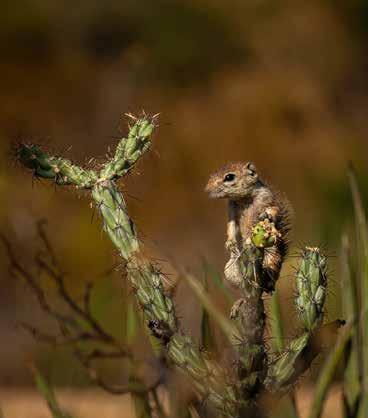 Don Powell
Don Powell
Our readers are not the only Arizona residents who have been enjoying some fun in the summer sun; our furry, feathered and scaly neighbors have also been doing so. Fortunately, we live in an area that makes it possible for them to visit us as we embark on exploratory hikes of our desert surroundings, enjoy dinner on our backyard patios and even gaze out the windows of our air-conditioned homes.
As the sun began setting, I waited for that perfect light with no hot spots and gorgeous color. I followed this one little owl all over Scottsdale Community College’s burrowing owl habitat and finally said out loud, ‘Please just land a little closer to me’ — and he did. I audibly squeaked and he looked right at me. I took my shot and it was my favorite of the day.
 Kelly Conrad
Kelly Conrad
Calderwood Butte is surrounded by open desert; so we have a large variety of wildlife, which includes coyotes, great horned owls, bobcats and — one of my favorites — chuckwallas. I hide behind some rocks up on the side of the butte and wait. During one of my most recent outings, I discovered that the male chuckwalla was not alone. I saw a little body come creeping up the side of the rock. I particularly love that the baby chuckwalla seems to already be imitating the behavior of the adult, perched up on the top of the rock to claim it as his own.
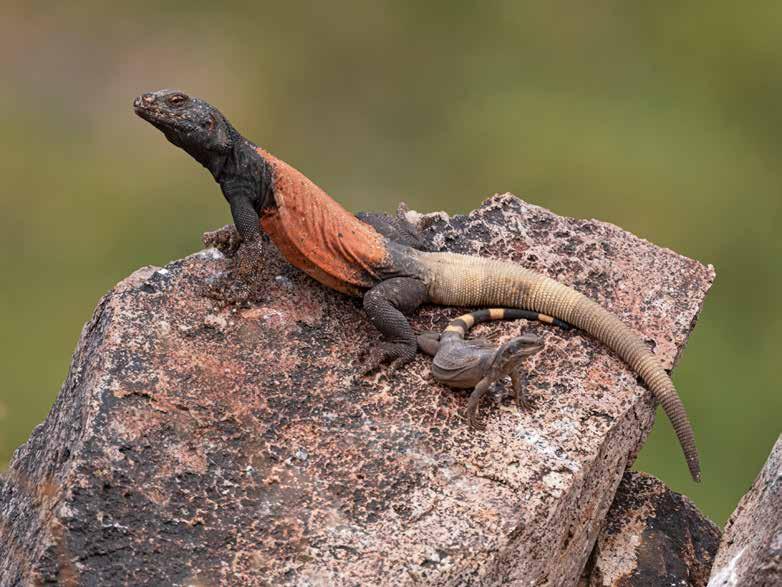 Sue Welter
Sue Welter
TThe Holland Center in North Scottsdale operates from the premise that art — painting, writing, music, theater and creativity — brings people together and contributes to the overall wellness of individuals and the community.
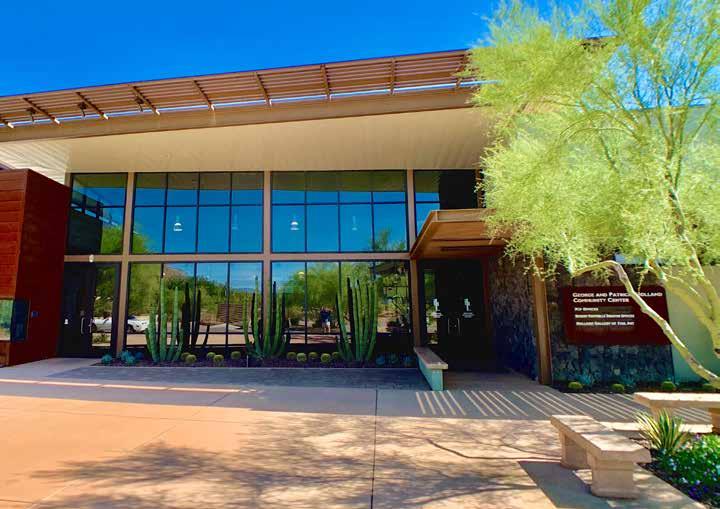
“We are the best-kept secret in the desert,” says Kellen Brugman, who is responsible for community development at the nonprofit center. “We want to get the word out so people know about The Holland Center; if we benefit one person in the family, we benefit the whole family unit.”
Back to school means back to routines of learning, homework and extracurricular activities. There are many opportunities to build skills and stave off after-school lolling about, but The Holland Center offers a myriad of options that meet the needs of mind, body and spirit while having fun and developing the whole person.
Tell Me A Story is a six-week creative writing program developed by The Holland Center’s executive director Jennifer Rosvall for third through fifth and sixth through eighth grades. The classes, which are part of a partnership with the center’s Desert Foothills Book Festival board, are taught by published authors and illustrators of children’s books. Students write and illustrate their own book and take home a published copy at the end of the session.
“Tell Me A Story meets kids where they’re at,” Brugman says. “Little ones learn what a story is and how to use illustration to read and tell the story. It develops brain-based health as they read stories out loud to one another.

“The older students learn about literary genres and [how to] determine what it is they want to write about — poetry, mystery, a travel adventure they’ve experienced. They learn about story arcs, character development, how to write dialogue and [how to develop] a compelling story. They also learn the business side of it — how authors market themselves and their books.”
The entire community can experience the upcoming second annual Desert Foothills Book Festival featuring local authors Saturday, Oct. 21 at The Holland Center.

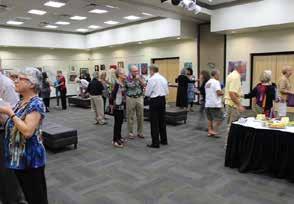

Brugman has also developed and serves as a teacher for the newest addition to The Holland Center’s youth lineup: Daily Routines for Stress Management, The Science of Awareness and SelfCare. The course is designed as an after-school program for high schoolaged students but has also been taught as part of a math and science summer bridge program at Cactus Shadows High School.
“We want kids to invest their time in creative endeavors after school rather than using devices that waste time,” Brugman says. “This course teaches easy, effective and enjoyable daily routines that address sleep habits, food choices, digestion, an understanding of the nervous system, goal setting and managing the use of personal technology.”
While schools are focused on fundamentals and meeting common core curriculum goals, external children’s arts programs are filling the gaps. Studies show that consistent participation in the arts actually increases academic performance. Sandi Carll
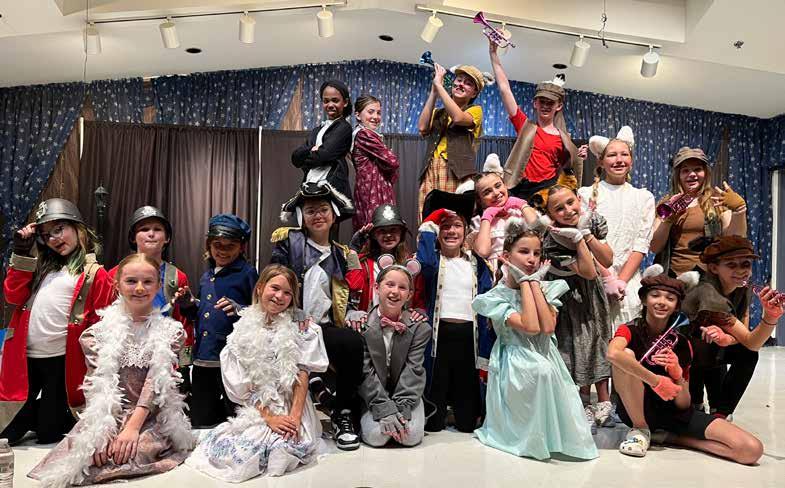
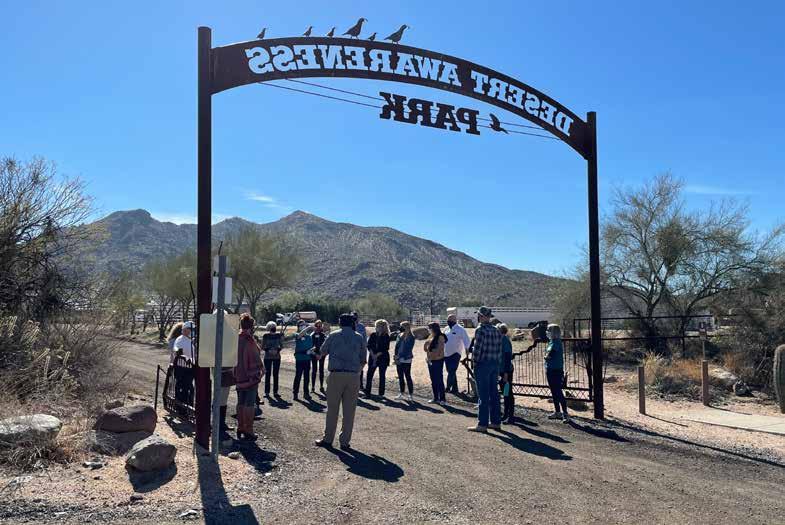
Brugman’s course helps students understand the three important areas of their lives where they can weave in routines — waking up; school assignments, tests and studying; and bedtime.
Thoughtful challenges are presented in ways that allow young people to try something new and see how it affects their lives for the better. For example, students experiment by spending 15 minutes at night outside in nature and take note of how they feel after that activity in comparison to spending 15 minutes on an electronic device, which can disrupt sleep rhythms and affect eye health and posture.
“Participants learn to use their senses in a way that supports the nervous system and connects them to nature or their family and friends instead of a limiting device,” Brugman says.
Desert Foothills Theater, led by producing artistic director Sandi Carll, will offer after-school theater programs with performance opportunities and theater productions for children ages 7–18 during its 2023–24 season. Professional performing artists work with young thespians to develop skills in acting, singing and musical theater dance while building stage and presentation skills.
“Today, live theater is more important than ever,” Carll says. “While schools are focused on fundamentals and meeting common core curriculum


goals, external children’s arts programs are filling the gaps. Studies show that consistent participation in the arts actually increases academic performance.”
Currently, children ages 6–12 can participate in Desert Foothills Theater’s no-cut production of “Roald Dahl’s Willy Wonka Kids.” Later this fall, the theater will hold auditions for its production of “Disney’s Aladdin, Jr.,” based on the 1992 Academy Awardwinning film and 2014 hit Broadway musical. “Seussical Kids” is also on this season’s roster, with auditions taking place just after the new year.


“Theater sparks the imagination, cultivates curiosity, empathy, literacy, courage and self-confidence,” Carll says. “Kids who participate in theater learn to be great collaborators, problem solvers and idea generators.”
hollandcenter.org
desertfoothillsbookfestival.com dftheater.org
IIt’s all there in black and white: the game of chess is hugely popular and, according to Dr. Debra Rose Wilson of Healthline Media, Inc., playing “can improve cognitive skills like memory, planning and problem-solving.” It’s that ability to stand back, assess what someone else might be thinking and visualize multiple scenarios that may be necessary to accomplish a task that is excellent practice for the game of life.
It’s also a lot of fun.
Chess Emporium is celebrating its 30th anniversary this year and has taught more than 100,000 children the game of chess since its founding in 1993. The company operates chess clubs in 388 schools around the Valley and has three physical chess centers located in Scottsdale, North Phoenix and Tempe.
The school clubs are primarily for kindergarten through sixth-graders, with a few that extend to eighth grade. High schoolers learn and play at the centers during the school year and can attend camps during holidays and summer vacation. Weekend tournaments develop further skills, friendships and the opportunities to compete for trophies as a team.

“Chess is pretty popular at the moment with shows like ‘Queen’s Gambit’ on Netflix,” says James Wicker, the director of business development at Chess Emporium. “We teach in public, charter and private schools and reach roughly 10,000 kids per year. You could name every city in Maricopa County and we are there in some type of form.”

Wicker himself is proof that it’s never too late to take up the game. After an injury that temporarily hampered his participation on his high school’s baseball team, he began playing chess at age 17. He loved it so much that, during college breaks, he continued to come back to work for the company as a chess teacher. As business development director, he’s helped create partnerships beyond the classroom with the Phoenix Suns and the Phoenix Mercury.
“Chess helped me,” Wicker says. “It teaches a lot beyond the game. Life skills like accountability, tenacity, grit; you have to work hard and understand your planning. Every game must be planned and is a whole new event.
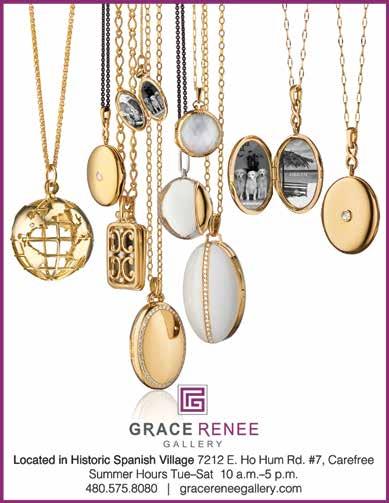
It teaches a lot beyond the game. Life skills like accountability, tenacity, grit; you have to work hard and understand your planning.
James Wicker


“I learned late but it helped me in college, especially as a college athlete. It was hard with practices, games, homework and classes. I had to be on top of things. In chess, if you’re not on top of every single move, you’ll lose quickly. I liked winning on and off the field — whether in chess or baseball.”
Chess Emporium’s chess centers offer structured monthly classes and the flagship program hosts about 200 students each month.

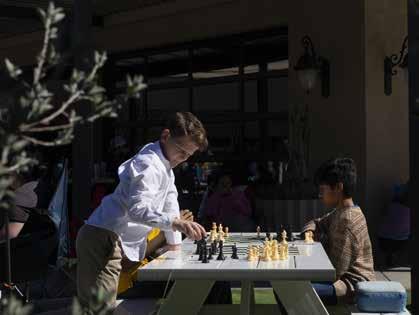

“They pick a class and time slot based on their level — pawn, knight, bishop, rook or queen,” Wicker says. “It’s very intense, detailed work; not casual play. They’re building strategy while learning opening principles, tactics and theory. A lot of kids like it better than the after-school clubs if they want to take the game more seriously.”
Wicker says there’s no stereotype for kids who get involved in chess. Across the board, all different interests, backgrounds and personalities are represented.
“I’ve seen kids go from building their brain power to developing in every aspect,” Wicker explains. “Chess is building skills for life. Some kids have begun reading two or grade levels higher or go from being a C student to an A student. It’s brain development away from screens. We don’t teach online other than an occasional instructional video. It’s over-the-board play and instruction is overthe-board.
“With the pandemic, a lot of kids are lacking confidence and social skills. Chess [builds] confidence in kids [and it’s] a building block for the future. These kids will be our future leaders and we are helping them develop skills at a young age.”
chessemporium.com

Serves: 4
For the Marinade:
2 tablespoons balsamic vinegar
1 tablespoon pesto
1 teaspoon olive oil
1 teaspoon honey
For the Chicken:
1-1/4 pounds boneless skinless chicken breasts
Kosher salt and black pepper
For the Salad:
5 ounces baby spinach
1 cup cherry tomatoes, halved
1 cup mini fresh mozzarella balls
Kosher salt and black pepper, to taste
Fresh basil
For the Pesto Dressing:
1/3 cup plain nonfat Greek yogurt
1/4 cup low-fat milk
1-1/2 tablespoons pesto
2 tablespoons shredded parmesan cheese
1 tablespoon apple cider vinegar
1/4 teaspoon granulated garlic
Kosher salt and black pepper to taste
Directions:
In a small bowl, whisk together all of the marinade ingredients until combined. Season chicken breasts with salt and pepper then place them in a gallon size freezer bag. Pour the marinade over the chicken and seal the bag, pressing out all of the air as you do. Massage the marinade into the chicken then place the bag in the refrigerator for at least an hour or overnight.
Preheat grill to medium-high heat and spray or brush the grates with oil. Place marinated chicken breasts on the grill and cook for 4–6 minutes per side. Remove chicken breasts from the grill and let rest for at least 5 minutes before slicing.
Place spinach on a serving platter or in a bowl. Arrange tomatoes, mozzarella balls and sliced chicken on top of spinach, then top with a sprinkle of kosher salt, freshly ground black pepper and fresh basil.
In a small bowl, whisk together all of the pesto dressing ingredients until combined. Drizzle the salad with the pesto dressing or serve on the side.
This grilled chicken caprese salad is perfect for summer feasting. The presentation is spectacular and the taste is so good! It’s also quick and easy to make, which is a huge bonus! Hearty, filling and still healthy — you’re going to love it!










